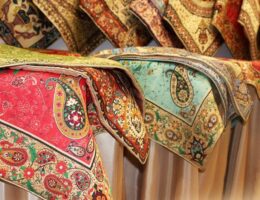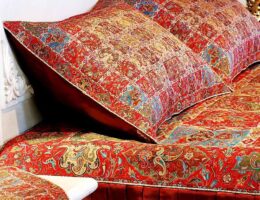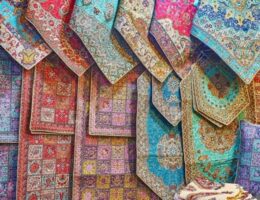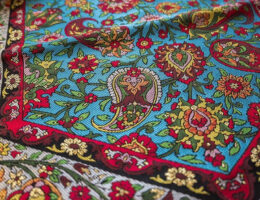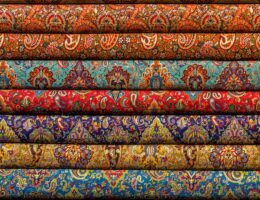IRAN ART EXHIBITION: INTRODUCING KILIM AND JAJIM HANDICRAFTS
Sirjan is considered as one of the centers of Iranian handicrafts. The culmination of these handicrafts is summarized in a kilim called The Shiriki Pich. Kilim is the handmade of women of Sirjan in the rural and tribal areas; the art which due to its characteristics, could transcended global boundaries. It would not be an exaggeration if we call it the most authentic and famous Iranian carpet. It orginated from the village Darestan, 25 kilometers from the center of Sirjan. This Kilim as it is called “Shiriki Pich” has been worldwide certified for more than two years with the approval of the World Crafts Council.
It is also called Shiriki Pich in the dialect of the nomads because of the cream color wrapped around the thread.
Some also argue that Shirki Pich or Shiriki Pich is a combination of two words Shirik and pich, each containing a separate argument. The name of the Pich comes from the twisted texture of the Kilim and is a name used in the past to this day. Sometimes the suffix Pich or Pich Baft are used in the nomad’s dialect as Glimpich, Kashkdan Pich, Ghashoghdan Pich. Shirik is originally a Turkish word means “partner” (in Afshar dialect). It is Shirik(Partner) because there have been more than one weaver working on the kilim. However, some believe that the Shirik Pich comes from wrapping the weft into two threads. The texture of the Shirik Pich is different from that of other carpets woven in Iran. The significant feature of this carpet is related to the weft which in other carpets causes the product to form, but in the Shiriki Pich the weft does not play a role in the texture and attaches the strands to each other and strengthens them with the “Che”, which leads to the weft being stuck and invisible in “Che”. The patterns of the Kilim are sometimes beyond the geometry and almost semicircular, depending on their particular features and texture. There is usually symmetry in the patterns, but in some cases this harmony obtained from the asymmetric patterns. The design of “Bote Jaghe” with two round flowers is seen in the Shiriki Pich patterns which is important for being marginal.
Shirkipich is the most common technique of carpet weaving in Sirjan region. There is no accurate information on the origin and texture of this technique in Kerman and Sirjan; but it is believed that the using of this technique in the nomad areas of Kerman was associated with the migration and exile of the Turk tribes during the Safavid era to Kerman. Shiriki Pich texture is the way most needles in the Caucasus and Asia Minor are woven. According to historical documents, this type of texture dates back to two thousand years BC.
IRAN ART EXHIBITION: There have been several important designs woven in this type of texture such as Stripes, Clay, Cladding, all types of head designs, three heads, Ostrich, Suture, Bergamot, Musa khani, Heshmat, Grape cluster, Pot, Kettle, types of bergamot, Tray, Bush, Cedar bush, King bush, combination type and etc. Some other patterns include Mouse tooth, Dotpo, Termeo, Claco, Scorpion, Chogon, Char pudo, Chogon, Sibak, Abbasi flower, Microbot, Ladder, quadrangle, Horn, Kale Ghouchi, seven colors, Haft Hashto and etc.
Carpet looms categorization:
Horizontal loom: This type is very simple and common among the tribes. This is how it is made: two straight and stiff beams are fastened parallel to each other at a fixed distance by four wooden or metal pins and the vertical strands are placed neatly on them. It has no side beams. The reason they use this type of loom is being easily portable and retractable, as they are constantly traveling.
Vertical loom: This type of hinged frame has a footrest at the top and a footrest at the bottom and can be mounted on the ground with vertical pedestals.
The game of colors in the Shiriki Pich kilim has made it even more nomadic. It has achieved a very good sale with high demands in recent years. In Germany, the heart of Europe Shiriki Pich kilim is known as “Iron kilim”. In fact, because of the strength and durability of this carpet it is called iron.
In Malik Abad, Zaidabad, and Mahmoudabad districts this knitting is seasonal. Due to the growing demand and therefore more production of this kilim, the number of weavers has increased to more than 10,000 in recent years in Sirjan and its suburbs. The global registration of the Shiriki Pich kilim has also doubled the production and export in recent years.

Antique Persian Jajim
Jajims are typically woven in square sizes and are most easily identified by their vertical stripe patterns. They flat woven kilim like carpets that originate from Iran and are woven in horizontal loom. The exact date these ancient cloths were first woven is not entirely known, though it is believed that some of the antique textiles illustrated in fourteenth century Persian paintings may have been jajims. Regardless of the exact year in which these extraordinary cloths were first created, it is clear that the jajim has a very long history and has held an important role in Iran’s artistic past.
The material used to make the jajims was usually wool, and the dyes used for older jajims were all vegetable-based. Sadly the number of antique Persian jajims that are left intact is decreasing rapidly, since it is a common practice to unravel these textiles and use them to repair and restore other rugs and flat woven kilims that may fetch a higher price.
IRAN ART EXHIBITION: Traditionally, Persian jajims served many purposes. Most frequently, they were used as bed covers in order to protect the wearer from the cold. Freshly-made jajims were often coarse and rough to the touch, but soon softened after frequent use. Often a family would place a charcoal brazier in the center of a jajim and all sit around it. Additionally, jajim owners would often spread them on the ground and sleep on top of them. Thicker jajims were employed as horse covers, while thinner jajims were frequently used for decoration and have been prized as luxury items in Iran for centuries.

